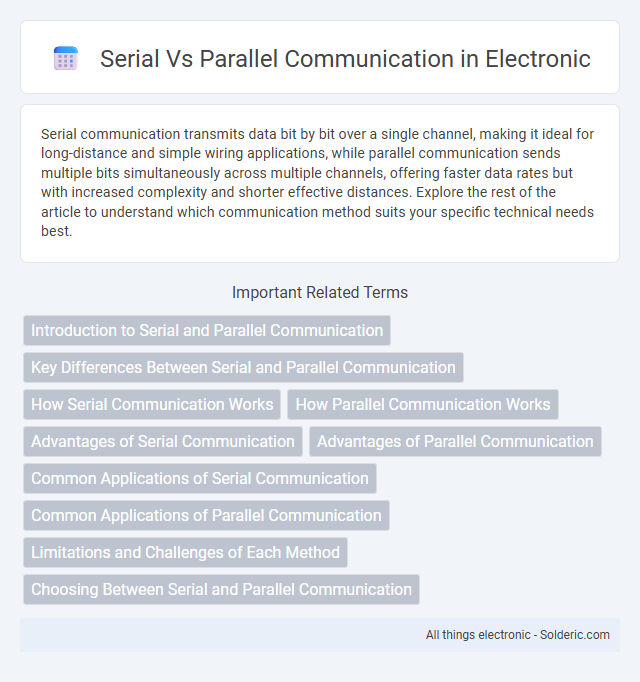Serial communication transmits data bit by bit over a single channel, making it ideal for long-distance and simple wiring applications, while parallel communication sends multiple bits simultaneously across multiple channels, offering faster data rates but with increased complexity and shorter effective distances. Explore the rest of the article to understand which communication method suits your specific technical needs best.
Comparison Table
| Feature | Serial Communication | Parallel Communication |
|---|---|---|
| Data Transfer | One bit at a time | Multiple bits simultaneously |
| Speed | Slower, depends on baud rate | Faster for short distances |
| Cable Complexity | Simple, fewer wires | Complex, multiple wires |
| Distance | Effective over long distances | Limited to short distances |
| Cost | Lower cost | Higher cost |
| Applications | USB, RS-232, Ethernet | Internal computer buses, printer interfaces |
| Interference | Less crosstalk, more reliable | Prone to crosstalk and noise |
Introduction to Serial and Parallel Communication
Serial communication transmits data one bit at a time over a single channel, making it ideal for long-distance communication due to reduced signal degradation and lower wiring complexity. Parallel communication sends multiple bits simultaneously across multiple channels, offering higher data transfer rates but is typically limited to shorter distances because of signal interference and synchronization challenges. Understanding the differences between these methods helps you select the most efficient communication protocol for specific electronic or computer systems.
Key Differences Between Serial and Parallel Communication
Serial communication transmits data bits sequentially over a single channel, making it ideal for long-distance communication due to reduced signal degradation and simplified wiring. Parallel communication sends multiple bits simultaneously across multiple channels or wires, offering higher data transfer speeds but suffering from timing skew and increased electromagnetic interference over longer distances. Key differences include transmission speed, distance limitations, cable complexity, and susceptibility to noise, with serial communication preferred for longer distances and parallel used in short, high-speed data transfers like internal computer buses.
How Serial Communication Works
Serial communication transmits data bits sequentially over a single channel, one bit at a time, making it efficient for long-distance communication. Each bit is sent in a timed sequence, synchronized by a clock signal or start/stop bits, ensuring accurate data transmission between devices. Your data flows through fewer wires compared to parallel communication, reducing complexity and cost in system design.
How Parallel Communication Works
Parallel communication transmits multiple bits simultaneously across multiple channels or wires, enabling faster data transfer compared to serial communication. Each wire carries a single bit, allowing an entire byte or word to be sent at once, which reduces latency for short-distance communication within devices like CPUs and memory modules. Your system's speed in handling data depends on the synchronization and timing of these parallel signals to avoid crosstalk and signal degradation.
Advantages of Serial Communication
Serial communication offers significant advantages such as simplified wiring with fewer data lines, which reduces cost and complexity in device interconnections. It supports longer cable lengths and higher data integrity due to reduced electromagnetic interference compared to parallel communication. Serial communication is ideal for long-distance data transfer in applications like USB, RS-232, and Ethernet protocols.
Advantages of Parallel Communication
Parallel communication offers significant speed advantages by transmitting multiple bits simultaneously across multiple channels, enabling faster data transfer compared to serial communication. This method reduces latency in short-distance data exchange, making it ideal for internal computer buses and memory interfaces. Higher throughput and efficient real-time data handling are key benefits of parallel communication in applications requiring rapid data transmission.
Common Applications of Serial Communication
Serial communication is widely used in common applications such as USB devices, RS-232 serial ports, and UART interfaces in microcontrollers due to its simplicity and long-distance data transmission capabilities. It supports communication protocols like SPI and I2C, essential for connecting sensors, memory devices, and peripherals in embedded systems. Your electronic devices frequently rely on serial communication for efficient, low-pin-count data exchange in networking, industrial automation, and consumer electronics.
Common Applications of Parallel Communication
Parallel communication is commonly used in applications requiring high-speed data transfer over short distances, such as internal computer buses like the PCI and IDE interfaces. Printers and older peripheral devices frequently utilize parallel communication to send multiple bits simultaneously for faster performance. Industrial automation systems also rely on parallel communication for real-time control signals where synchronization and speed are critical.
Limitations and Challenges of Each Method
Serial communication faces limitations in data transfer speed due to its sequential data transmission, which can become a bottleneck in high-bandwidth applications. Parallel communication encounters challenges related to signal degradation and crosstalk over longer distances, limiting its effective range. Your choice between these methods should consider the balance between speed requirements and physical constraints like cable length and electromagnetic interference.
Choosing Between Serial and Parallel Communication
Choosing between serial and parallel communication depends on your application's data transmission speed and distance requirements. Serial communication, using fewer wires, is ideal for long-distance and reduces signal degradation, while parallel communication transmits multiple bits simultaneously, offering higher speeds for short distances. Your system's design constraints, such as cost, complexity, and electromagnetic interference, also influence the optimal communication method.
Serial vs Parallel communication Infographic

 solderic.com
solderic.com